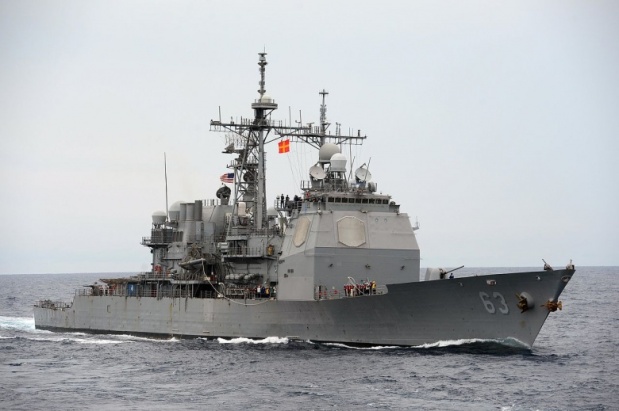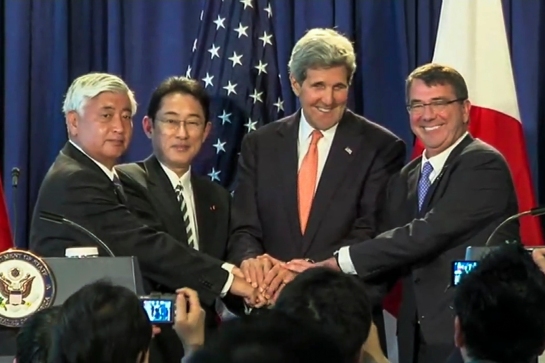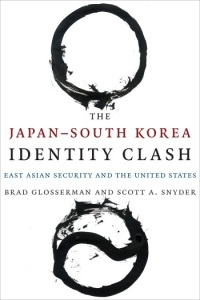How America can stop China in the South China Sea
The National Interest, May 27, 2015
The release of a U.S. Navy P-8 video flying over the South China Sea was a shock to many. The footage revealed a small armada of dredging vessels, support ships, and auxiliaries, working diligently to build what looked like People’s Liberation Army Navy and Air Force bases. According to international law, most islets China has occupied lie within the territorial waters of either the Philippines or Vietnam, and Chinese actions could be interpreted as maritime invasion. Despite Chinese claims to the contrary, neither Chinese behavior, nor its 9 dotted line, are consistent with customary international law or by the UN Convention on the Law of the Seas. Nor do it’s historical claims stand real scrutiny as a recent piece by South China Sea scholar, Bill Hayton, shows.
China’s actions, therefore, represent an infraction of the internationally agreed upon system of rules and are a major challenge to the current global maritime order, particularly since it takes place across one of the world’s most vital shipping arteries. In essence, China is building military installations on false reefs across one of the world’s busiest sea lanes, giving them control over those sea lanes. One might argue, that it is as much a challenge to international peace and security as was Russia’s annexation of the Crimea. If China is allowed to create islands in such a manner, what’s to stop a slew of global imitators? More to the point, what exactly is China’s strategic aim and what can the United States and its allies do about it?
Some might argue that China views the international system with cynicism, having been prey to Japanese and Western imperialism during the 18th and 19th centuries. China’s behavior, they say, is merely a means of protecting itself from the types of naval intrusions that it suffered historically and that it is building a “Great Wall of Sand,” to consolidate its First Island Chain. This argument is, at first appearance, a sound one. After all, there is some truth to the argument that Chinese naval behavior is predicated on a political historical narrative of weakness and foreign predation. Certainly, much of what China is doing is explained this way domestically to an increasingly nationalist audience at home.
However, China has shown itself to be willing to adopt elements of the international system which favor its interests; its membership in the UN Security Council and a number of international fora, like the WTO, World Bank, and many others reveal this buffet approach to the current order. Furthermore, under closer examination, China’s narrative of weakness—the so-called “100 years of humiliation”— is little more than clever posturing and historical selectivity. The narrative cleverly highlights predation on the part of the West, while papering over China’s own Imperial Qing (1644-1912) predation and colonization of neighbors Tibet, Vietnam, Dzungaria, and Formosa (Taiwan). In many ways, the 100 years narrative is used being used internally to justify China’s behavior in a similar way Berlin used the “shameful peace at Versailles” to mobilize Germany’s domestic politics in the inter-war period. When rising powers begin using the ‘victim card’ to justify their expansionist aims, we should all pay attention.
The historical similarity to Germany’s efforts to control its periphery during this the 1930s and China’s maritime expansionism might serve as a framework for how the US and its allies should build a political-military counter strategy. One immediate implication of the historical framework is to avoid any policy of appeasement; history teaches us that appeasement merely facilitated war in the end as Hitler’s ambitions were fed by the Rhine area and the Sudetenland. China’s strategy seems to hold a similar geopolitical logic to Germany’s territorial claims of the time. Certainly undersea gas fields and fertile fishing waters play a role, but fundamentally, China’s action has been about taking control of sea-lanes. This is in essence the first step in a three pronged strategy: first, dominate the South China Sea with Chinese military forces; second, use this de facto control to gradually and incrementally develop a new benevolent Sino-centric system in Southeast Asia; one in which ASEAN states implicitly submit their foreign and security policy to Chinese approval; third, use this control to exert pressure on Seoul, Taipei, Manila and Tokyo—four U.S. allies, heavily dependent on the sea-lane, which transits the South China Sea. This last policy is meant to be gradually expel the US from the region, without firing a shot. China’s control over those states lets them know, who really controls their destiny.
The only way to counter this grand strategy would be for the United States to incrementally shift the balance of its hedging policy away from one of engagement more to one of political and military balancing. The United States might adopt a two-pronged political and military strategy in close consultation with its friends and allies in the Asia Pacific region. However, it cannot afford to walk too far forward of regional public opinion; it must seek to maintain the moral high ground afforded it by China’s actions by walking in lock-step with regional partners. The first step should be to begin a long-term, multilateral diplomatic push at states in the region for a conference to cease militarization of the seas. The date of such a conference should be at least six months in the future, to give the US and its allies time enough to coordinate a concerted diplomatic push at fence-sitting states in the region, particularly the “flip” states Indonesia and Malaysia. US diplomats might trial this at the Shangri-La conference later this week. After all, even Chamberlain had a “Munich.” The failure of the United States and its allies to get China to a conference up until this point is indicative of the success of China’s salami slicing approach.
Secondly, in order to pressure China to the table, the United States must assist a concerted strategic change in the military posture of the Philippines and other like-minded states. With American, Japanese and Australian help, the Philippines should build up strong asymmetric capability, known as anti-access, area denial (A2/AD). Radar systems, mobile anti air-and-ship missile systems should be built up en masse so as to counter Chinese attempts to dominate the sea and air in and around the South China Sea. Such systems should be able to reach far into the South China Sea, and fundamentally challenge Chinese attempts to dominate the immediate domain. Such a strategy would nullify China’s new bases, making them virtually useless, while remaining defensive and non-provocative. Other ASEAN states interested in such defense technologies should also be considered for the program.
If such a strategy were well-funded, it would make things very difficult for Beijing. Of course, the PLAAF could react by hardening their airfields, and their presence would continue to be a peace-time source of leverage, but at least this leverage would be somewhat ameliorated tactically. Furthermore, their use as actual air fields in times of actual conflict would be challenged completely from Philippine air space. Such a tactic, if carried out incrementally and in response to Chinese efforts, would present Chinese strategists with a dilemma. If they continue to build up their forces, U.S. and allied forces would simply respond in kind. If they seek diplomatic redress, then both sides freeze the build-up. In many ways, this tactic would solve the age-old conundrum of how to get Beijing to parlay at the diplomatic conference described above. It would also counter the historical problem of appeasement or ‘rolling ambition’, the ever-increasing appetite for territory of challenging states.
At present, the policies of the United States and its allies are behind events on the ground. True, the new U.S.-Japan Defense Guidelines are a step in the right direction, and US-Japan-Australia capacity building efforts are becoming increasingly coordinated in Southeast Asia, but China is moving faster than many could have anticipated. No doubt, Beijing feels it must move fast, perhaps in expectation of the long-predicted slowdown of its economy. China is getting the goods, while the going is good. If the United States and its allies want to stop this, they must think fast and act faster. Certainly, such a strategy as outlined above, might be the first step in taking away the initiative, something Beijing has very much kept until now.



